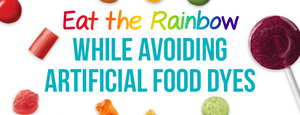
Eating the Rainbow While Avoiding Artificial Food Dyes
We are often encouraged to “eat the rainbow.” A colorful plate means you’re loading it up with fruits and vegetables, and more importantly, nutrients – right?! We eat with our eyes, and we don’t mean overfilling your plate with way more than you can fit in your belly. We eat the colors that resonate with us and what looks delicious (before we know how delicious it really tastes!)
The colors of food even relate to feelings and familiar tastes. You might chomp on a juicy red apple or fresh bell peppers and feel elated from the stimulating sweetness. To feel a burst of tart, sour energy, snack on a crisp salad of bitter greens and herbs. And the rainbow continues...
But filling your plate with the entire rainbow of colorful produce is not always the better-for-you choice because of artificial food dyes – the biggest culprits on our Most Wanted: Food Additives to Avoid list.
The fight against artificial food dyes is nothing new and the US has successfully banned many artificial food coloring additives. Unfortunately, there are still a few offenders left that the FDA allows.
Where can you find artificial food dyes?
Cereals, baked goods, and sweets are usually guilty of containing these man-made chemicals. Many consumers don’t realize that artificial food dyes can actually be found in produce and “healthier choice” packaged foods, like frozen veggies and dried fruit.
Why are they adding artificial coloring? What’s the point?! The brighter, more colorful the food is, the better we think it tastes. Especially our children, who wouldn’t want to snack on a dull looking piece of fruit. Yes, even some “fresh” fruits use artificial dyes to appear more vibrant.
You can feel safe from artificial food dyes when eating food labeled as USDA certified organic because these products must contain at least 95% organically produced ingredients and cannot contain preservatives or pesticides. We always recommend checking the ingredients label, just in case, for any of these additives: Blue 1, Blue 2, Green 3, Red 40, Red 3, Yellow 5, Yellow 6, and Citrus Red 2. Artificial food color can also just be listed at “Artificial Color.”
What are the alternatives to artificial additives?
All YumEarth organic candy and treats are colored with your favorite, naturally colorful, real fruits and vegetables. Not only are you getting a trusted organic treat, but you’re not getting any of the side-effects that come from ingesting artificial food dyes.
Artificial dyes found in your kids’ favorite non-USDA-certified organic snacks could be causing them to act out, feel irritable and stressed, and even induce allergies and insomnia. Behavioral problems have been linked to artificial dyes like Red 3 and Yellow 5 – both commonly found in popular candy brands that are probably in your pantry right now.
Out with the old, in with the new! New Giggles organic chewy candy that is. They aren’t the crunchy on the outside, chewy on the inside candy that you’re used to – they are better! While your usual household candy might be causing side effects in your kids, Giggles are made with simple coloring ingredients as our – NO artificial additives.
Giggles are just as colorful and flavorful as comparable candies. That’s right, it doesn't have to take an artificial Red 3 or Yellow 5 to create brilliantly colored candy. Ingredients like radishes, carrots, sweet potatoes, and blackcurrant make up the five colors of Giggles (without making them taste like carrots, of course)! The same goes for YumEarth organic lollipops, fruit snacks, and other sweet treats.
Other common alternatives to artificial color include beets, spinach, pumpkin, berries, cabbage, and turmeric. While natural colors in place of artificial colors might not be as bold or concentrated, feel proud to enjoy the colors of the rainbows on your plate or as an after-meal sweet treat without putting your family at risk.
For as long as the United States allows food products to include artificial dyes, the responsibility lies on companies like YumEarth to make better choice products for consumers; and it’s up to the consumers to make better choice purchases for their families. This starts with shopping USDA-certified organic products whenever possible, from the fresh fruit in your fridge to the lunch box snacks in your pantry.